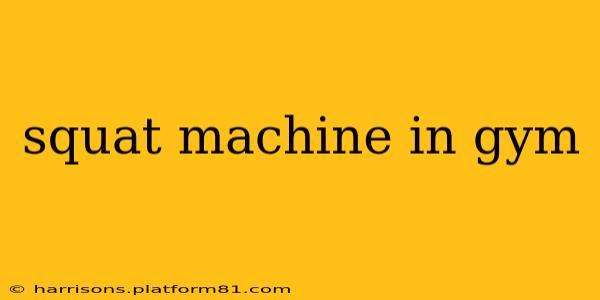The squat machine, a staple in most gyms, offers a fantastic way to build leg strength and muscle mass. Unlike free weight squats, the machine provides stability and support, making it ideal for beginners or those recovering from injuries. However, understanding proper form and technique is crucial to maximize benefits and minimize risk of injury. This comprehensive guide will delve into everything you need to know about using the squat machine effectively.
What are the benefits of using a squat machine?
The squat machine offers several advantages over free weight squats:
- Improved Stability: The machine's design provides support, reducing the risk of losing balance and preventing injuries. This makes it particularly beneficial for beginners who are still developing their balance and coordination.
- Reduced Risk of Injury: The guided movement minimizes the chance of improper form leading to strains or tears. This makes it safer than free weights, especially for individuals with pre-existing conditions.
- Easier to Learn: The machine's structure guides the movement, making it easier to learn the correct squatting technique compared to free weight squats.
- Focus on Muscle Engagement: By eliminating the need for balance, you can concentrate more fully on engaging your leg muscles, leading to more effective workouts.
- Adjustable Weight: Most squat machines allow you to adjust the weight incrementally, allowing for progressive overload and continuous improvement.
What muscles does the squat machine work?
Primarily, the squat machine targets the major muscle groups in your legs:
- Quadriceps: These muscles at the front of your thighs are heavily engaged during the squat movement.
- Glutes: Your glutes, or buttocks muscles, are crucial for hip extension and power generation during the squat.
- Hamstrings: Located at the back of your thighs, the hamstrings assist in hip extension and knee flexion.
- Calves: These muscles in your lower legs are also engaged to a lesser degree during the squat.
How do I use a squat machine correctly?
Proper form is paramount to prevent injuries and maximize results. Follow these steps:
- Adjust the Seat Height: Adjust the seat height so that your thighs are parallel to the ground when your knees are at a 90-degree angle. Your knees shouldn't extend past your toes.
- Adjust the Shoulder Pads: Ensure the shoulder pads are positioned comfortably across your upper back and shoulders to secure your upper body.
- Foot Placement: Place your feet shoulder-width apart, slightly pointed outwards.
- Begin the Movement: Slowly lower yourself by bending your knees and hips, keeping your back straight and core engaged. Maintain a controlled descent.
- Return to Starting Position: Push through your heels to return to the starting position, ensuring the movement is smooth and controlled. Avoid jerky motions.
- Breath Control: Inhale as you lower yourself and exhale as you push back up. This helps maintain stability and control.
What are some common mistakes to avoid when using a squat machine?
Several common mistakes can hinder your progress and increase injury risk:
- Bouncing at the Bottom: Avoid bouncing at the bottom of the squat. Maintain a controlled movement throughout the entire range of motion.
- Rounding Your Back: Keep your back straight throughout the exercise. Rounding your back can lead to back pain and injury.
- Knees Going Past Toes: Ensure your knees don't extend past your toes during the squat. This can put excessive stress on your knees.
- Not Engaging Your Core: Engaging your core muscles throughout the movement helps to stabilize your body and protect your spine.
- Using Excessive Weight: Start with a lighter weight to focus on proper form and gradually increase the weight as you get stronger.
Is the squat machine good for beginners?
Yes, the squat machine is excellent for beginners. Its stability and support minimize the risk of injury, allowing beginners to learn proper squatting technique before progressing to free weight squats. It's a great tool for building a solid foundation of leg strength.
How many sets and reps should I do on the squat machine?
The ideal number of sets and reps depends on your individual fitness goals. For muscle hypertrophy (muscle growth), aim for 3-4 sets of 8-12 repetitions. For strength building, try 3-5 sets of 4-6 repetitions. Remember to always listen to your body and adjust accordingly.
What are some alternatives to the squat machine?
While the squat machine is a valuable tool, other exercises can also work your leg muscles:
- Free Weight Squats: A more challenging exercise requiring better balance and coordination.
- Leg Press: Another machine that targets similar muscles but involves a different movement pattern.
- Lunges: A bodyweight exercise that works your legs individually.
- Goblet Squats: A variation of the free weight squat that involves holding a weight close to your chest.
By following these guidelines and prioritizing proper form, you can safely and effectively utilize the squat machine to achieve your fitness goals. Remember to consult with a healthcare professional or certified trainer before starting any new exercise program.
